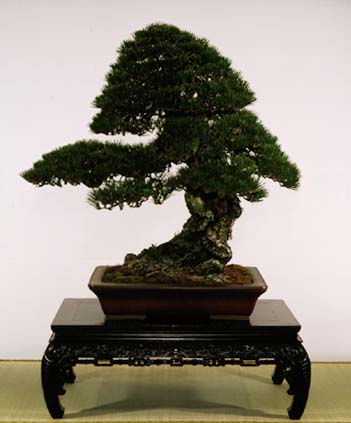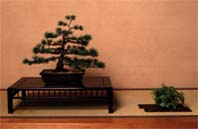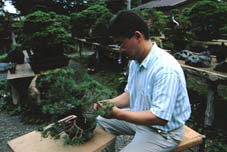WHAT ARE BONSAI?
|
The oldest mention of the word bonsai comes up in a mid-fourteenth
century poem, but it wasn't until around three centuries later that
people began using it regularly. Early bonsai can be seen in picture
scrolls, though, dating as far back as 1309.
In ancient times bonsai were usually enjoyed by aristocrats, priests,
and other high-ranking people, but from around the seventeenth century,
commoners began delighting in them, too. After Japan ended three centuries
of isolation in 1868 and opened itself up to Western countries, bonsai
came to be appreciated as objects of art, and people began growing bonsai
not just as a hobby but also as an artistic pursuit. Large-scale bonsai
exhibitions were staged, and scholarly books on growing techniques were
published.
Caring for bonsai is no longer just a Japanese pastime. More than 1,200 people
from 32 countries attended the World Bonsai Convention that was held
in the city of Omiya, Saitama Prefecture, in 1989. The convention helped
launch the World Bonsai Friendship Federation, which has been a driving
force in popularizing bonsai and raising bonsai-growing skills around
the world. The association has organized international conventions about
once every four years since the Omiya gathering; so far, they've been
held in Florida in the United States and Seoul in South Korea. The next
convention, set for 2002, will be in Munich in Germany.
Types of bonsai
All sorts of trees and shrubs are used as bonsai.
In essence, any plant that can be grown in a small container can be
cultivated as a bonsai. The most popular varieties are pines; maples,
whose leaves change their color in autumn; flowering trees, like the
cherry and plum; and fruit-bearing trees, like the quince and persimmon.
In countries other than Japan, varieties that are best suited to the
local climate are used. The trees can grow as tall as a meter (three
feet), or be small enough to be fit in one's palm.
Bonsai fall into a number of categories according to shape, but the
most important thing to keep in mind is to allow the tree to express
its individuality freely, without forcing it to fit any particular category,
and to help it achieve its most beautiful, balanced form.
Just as people choose clothes in which they look good, containers
should be chosen that best suit the trees in terms of size, shape, and
color. This will allow the bonsai to be seen in the loveliest light.
The trees have a life of their own, of course, and grow in accordance
to the laws of nature, so they can never be completely controlled by
humans. The key is not to force your will on them but to appreciate
the dignity of each living plant and treat them with love and respect.
Bonsai that have been watered and lovingly looked after day by day
can make a deep and lasting impression on the viewer--particularly when
such trees are centuries old and have been handed down from one generation
of bonsai lovers to another.
Unlike other works of art, there are no such thing as "finished"
bonsai as long as the trees are still alive and growing; they must continue
to be tended to on a daily basis. That's why bonsai growing is sometimes
called an art without end. For many enthusiasts, though, it's precisely
this timelessness that makes raising bonsai so rewarding and worthwhile.
|
|
Photos: (Top) A beautiful Kuromatsu on display (Courtesy of Nippon Bonsai Association); (middle) bonsai are often used to decorate the home; (above) the trees take lots of care. |
 Bonsai are trees and plants grown in containers
in such a way so that they look their most beautiful--even prettier
than those growing in the wild. Cultivating bonsai, therefore, is a
very artistic hobby. It's also a good illustration of the gentle respect
Japanese have for living things and an expression of their sense of
what is beautiful. It's much more involved than growing potted flowers,
and requires a much bigger commitment--physically and emotionally.
Bonsai are trees and plants grown in containers
in such a way so that they look their most beautiful--even prettier
than those growing in the wild. Cultivating bonsai, therefore, is a
very artistic hobby. It's also a good illustration of the gentle respect
Japanese have for living things and an expression of their sense of
what is beautiful. It's much more involved than growing potted flowers,
and requires a much bigger commitment--physically and emotionally.
 Today, growing bonsai continues to be a hobby enjoyed by members of the general
public. It's also regarded as an important part of Japan's cultural
and artistic tradition, nurtured over the years by the nation's climate
and people's love of nature.
Today, growing bonsai continues to be a hobby enjoyed by members of the general
public. It's also regarded as an important part of Japan's cultural
and artistic tradition, nurtured over the years by the nation's climate
and people's love of nature.
 The
process of raising bonsai requires controlling the kind of shape the
trees take. Sometimes you need to bend branches with wires or to cut
them off altogether. You might think that's cruel, but these steps are
essential for the tree to remain healthy in a pot.
The
process of raising bonsai requires controlling the kind of shape the
trees take. Sometimes you need to bend branches with wires or to cut
them off altogether. You might think that's cruel, but these steps are
essential for the tree to remain healthy in a pot.